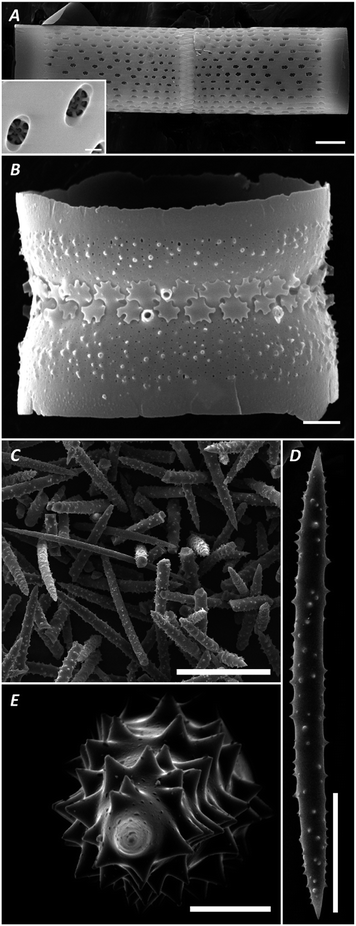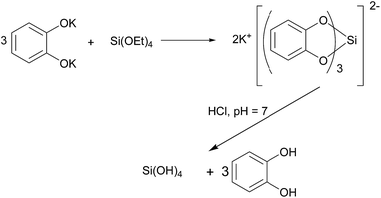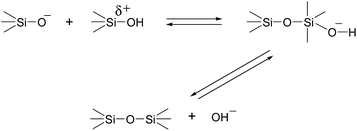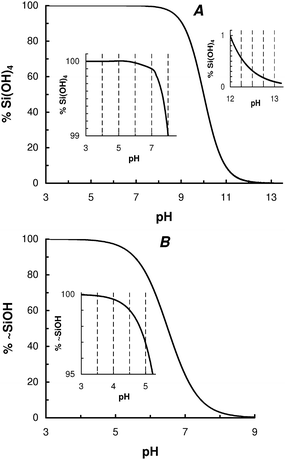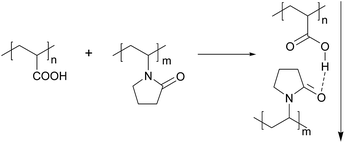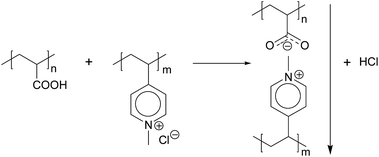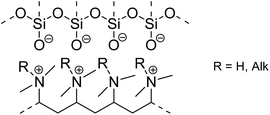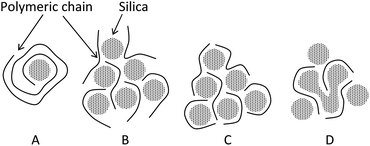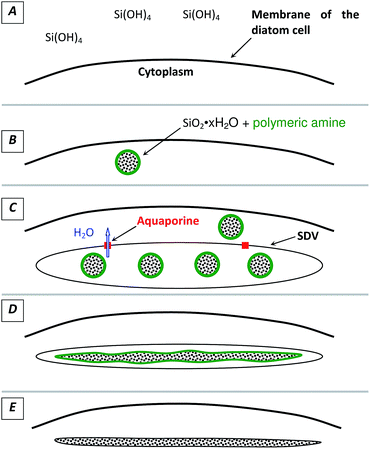 Open Access Article
Open Access ArticleSilicic acid condensation under the influence of water-soluble polymers: from biology to new materials
Vadim V. Annenkov
 *a,
Elena N. Danilovtseva
a,
Viktor A. Pal'shin
a,
Ol'ga N. Verkhozinaa,
Stanislav N. Zelinskiy
a and
Uma Maheswari Krishnan
b
*a,
Elena N. Danilovtseva
a,
Viktor A. Pal'shin
a,
Ol'ga N. Verkhozinaa,
Stanislav N. Zelinskiy
a and
Uma Maheswari Krishnan
b
aLimnological Institute of the Siberian Branch of the Russian Academy of Sciences, 3, Ulan-Batorskaya St., P.O. Box 278, Irkutsk, 664033, Russia. E-mail: annenkov@lin.irk.ru; annenkov@yahoo.com; Tel: +7-9148982577
bCentre for Nanotechnology & Advanced Biomaterials (CeNTAB), School of Chemical and Biotechnology, SASTRA University, Thanjavur – 613401, Tamil Nadu, India
First published on 12th April 2017
Abstract
Silicon is among the most abundant elements on the Earth. It occurs in many minerals and plays an important role in several biochemical processes. Some living organisms use silicon dioxide as a substrate for building elements of their bodies. Unicellular diatom algae build frustules from silicon dioxide. The skeleton of siliceous sponges is a silica–protein composite. Similarly, rice hulls which protect seeds, contain silica as an important component. The living organisms assimilate silicon from the environment in the form of silicic acid. However, the biochemical mechanisms involved in the transformation of silicic acid to solid siliceous materials are still poorly understood. Evidently, condensation of silicic acid in the living organisms proceeds under control of biopolymers and it is important to know how various types of polymers influence the condensation. Bio-inspired chemistry involving the interaction between polymeric silicic acid and functional polymers results in interesting composite materials, including nanoparticles and bulk materials. This review contains a brief description of the mechanism of silicic acid condensation in aqueous medium and also includes a discussion on various precursors of silicic acid. The main focus of the review is on the influence of polymers bearing nitrogen and oxygen-containing functional groups on silicic acid condensation starting from monomer to three-dimensional polymer. Influence of molecular weight of the organic polymer on the condensation and structure of the resulting product is also elaborated. The biological importance of the obtained data and strategies for novel applications of the synthesized composite materials are described in the concluding section of the review. The biomimetic condensation processes open up new vistas for development of novel materials and applications in the biomedical and process industries.
Introduction
Silicon is among the most abundant elements on the Earth, it occurs in many minerals and plays an important role in biochemical processes. Some living organisms use silicon dioxide as a structural material in their bodies.1 Diatom algae are unicellular organisms which provide more than 20% of photosynthetic oxygen and contribute to a corresponding amount of primary organic production.2 The diatom cell lives in a “glass house”3 – siliceous frustule built from silicon dioxide in a form similar to molten quartz glass (Fig. 1A). Sponges belong to a class of ancient and interesting invertebrates which play an important role in ecosystems as filtering organisms. They also serve as a residence for an enormous number of symbionts. Sponge bodies are inexhaustible source of biologically active compounds.4 Siliceous sponges represent more than 90% of sponges5 and their skeleton is based on siliceous spicules – composite needle-like constructions (Fig. 1B). Rice (Oryza sativa) is a staple crop consumed predominantly by the Asian population. It has been found that the xylem sap in these plants are rich in silicic acid. The role of silicon in augmenting disease resistance,6 chlorophyll a content and growth7 of rice plants has been demonstrated by different research groups. Silica deposits have been found in the cell walls of rice plants and it has been postulated that these silica deposits enhance the stability of the cell wall structure during mitotic cell division.8 Similarly, silicon deposits have also been identified in the stomata of rice plants and it is believed that these deposits tend to reduce water loss through transpiration.9 The nano-dimensional silica particles in rice are believed to be formed using hemi-cellulose callose as a template.10 Biogenic silica and composites are a great challenge to material science specialists because these materials are highly ordered at various levels and a lot of them, e.g. diatom frustules consists of a material similar to melting quartz glass11 which artificial analogs are produced at temperatures above 1000 °C only. Siliceous organisms put many questions to biologists and biochemists: how living organisms capture silicon from the environment? How they store and transport silicon in their bodies? How they build highly ordered constructions from silicon dioxide without high temperatures and hazardous chemicals?Silicon is present in natural water mainly in the form of monomeric silicic acid. Evidently, transformation of Si(OH)4 to solid SiO2 or siliceous composites proceeds through condensation in the presence of some organic substances, probably biopolymers. The nature and action mechanism of these substances is yet not thoroughly deciphered. The main approach to discovering novel biosilicification agents involves isolation and separation of organic substances from biosilica, structure identification, study of silicification activity using in vitro models, monitoring the transformation of the molecule of interest in the organism and finally formulation of the hypothesis on the mechanism of biosilicification. This strategy had resulted in the discovery of silaffins – proteins with phosphate and polyamine post-translation modifications12,13 and silicateins – proteins capable of catalyzing hydrolysis of Si–O–C bonds.14 The growing interest in biosilicification during the last few decades has resulted in concerted research efforts devoted to aqueous phase silicic acid condensation in the presence of organic polymers bearing functional groups similar to groups in the hypothesized natural silicification agents. Such studies have at least two objectives – to understand biological processes with simpler and available models and to obtain new bioinspired material, including nanoparticles and bulk composites with the intricate and complex morphologies commonly encountered in the biological systems.
This review summarizes information about Si(OH)4 condensation in aqueous medium in the presence of oligomeric or polymeric molecules capable of interacting with monomeric or polymeric silicic acid. Biological importance and possible applications of these materials are also discussed. Siliceous materials are intensively studied in various fields and we limit this review with water-based systems where free silicic acid is evidently present and plays an important role.
Precursors of silicic acid
Silicic acid is not stable in the free state and hence it is produced in situ from various precursors. The most simple and cheap precursors are inorganic silicates like sodium, potassium silicates and liquid glasses of variable composition, e.g. Na2O·xSiO2.15 Silicic acid is a very weak acid (pKa = 9.7–9.9)16,17 and addition of acid to a solution of inorganic silicates results in formation of Si(OH)4. The other convenient way to obtain silicic acid from inorganic silicates is through the action of cation-exchange resin in H-form. This procedure facilitates the formation of Si(OH)4 solution free from inorganic salts. Siliceous sols were prepared by acidification of sodium silicate solution with HCl (pH = 1–2) following with action of a cation-exchange resin which removes Na+ ions.18 The obtained solutions were not analyzed and it seems that monomeric silicic acid is the main component of these solutions because Si(OH)4 is stable in acidic area.19There are also several organic derivatives of silicic acid which are easily hydrolyzable in aqueous medium. Tetramethyl orthosilicate Si(OMe)4 (TMOS) interacts with water and gives rise to silicic acid and methanol in approximately ten seconds. TMOS is usually added to 1–2 mM HCl solution which prevents Si(OH)4 from condensation during hydrolysis.20,21
Silicon catecholate salts are obtained by the reaction between 1,2-dihydroxybenzene (catechol) salt and tetraethyl orthosilicate (TEOS).22 These compounds are readily hydrolysable at neutral pH values as shown below:
The first study on silicon catecholate salt hydrolysis23 showed that the concentration of the complex reduces from 50 mM to 20–28 mM during the first 2 min of the reaction and these levels remained virtually unaltered even after 24 h. These data however are in contradiction with the results24 reported for potassium silicon catecholate salt (K2-SiKat) which showed a decrease of K2-SiKat concentration from 30 mM to 0.1–0.7 mM immediately after the pH was adjusted to 7.
Tetrakis(2-hydroxyethyl)orthosilicate (THEOS) was obtained by the reaction between TMOS and ethylene glycol25 as follows:
This is a water soluble compound which on hydrolysis gives rise to silicic acid. THEOS was recommended as the precursor for synthesis of unshrinkable silica gels in aqueous medium.26 There is however, no information about the hydrolysis rate for THEOS and hence participation of partially hydrolyzed forms in the condensation reaction cannot be excluded.
Inorganic silicates produce silicic acid immediately after neutralization with acid and the only byproduct formed is inorganic salt, e.g. NaCl. Hence these compounds are most suitable for study of mechanism of silicic acid condensation and for simulating biochemical reactions. On the other hand, the fast hydrolysis rate and alkaline nature of the silicates complicates experiments and can result in irreproducibility. Organic precursors do not have these disadvantages and can be applied for design of siliceous materials. But the stepwise hydrolysis and formation of organic byproducts decrease the utility of these compounds to serve as precursors of Si(OH)4.
Silicic acid condensation in aqueous medium
Condensation of silicic acid has been extensively studied for many decades and it is described in several books and reviews.19,27–31 We describe here the main peculiarities of the reaction in aqueous medium.Silicate ions SiO44− are stable at high pH values but at pH 13 formation of oligosilicate particles containing several silicon atoms was observed.32 The condensation proceeds as a nucleophilic substitution reaction (SN2) between ∼Si–OH and ∼Si–O− moieties through a pentacoordinated transition state:27,33–37
This reaction requires ionized silanol and neutral ∼Si–OH groups. The first ionization constant of Si(OH)4 (pKa1) is 9–1016,17,38–45 and the subsequent pKa values are estimated as 11.7–13.4.17,38–45 While discussing quantitative values concerning silicic acid, we must remember that Si(OH)4 is highly unstable and exists at low pH or in very diluted solutions only. In other cases, various condensed forms appear in several seconds which poses a challenge to the investigators. So, we have some intervals in the measured values. Condensation of silicic acid is a reversible process and the minimal concentration of monomeric Si(OH)4 in equilibrium with solid silica or condensed soluble siliceous particles is estimated as 2–3 mM.19
Assuming pKa1 as 10, one can calculate the dependence of the concentration of unionized Si(OH)4 species on pH (Fig. 2A). The ∼Si–OH moieties occur at relatively high pH and according to our observations, 100 mM aqueous solutions of sodium silicate contain >50% of oligosilicates after several weeks of storage. A decrease in pH to 9.5–10.5 results in formation of considerable amounts of Si(OH)4 and Si(OH)3O− molecules which leads to fast condensation of the silicic acid monomers. Further decrease of pH to 7 and below results in almost completely unionized silicic acid and the condensation rate drops.
The other participant of the condensation reaction is oligosilicate molecules or poly(silicic acid) (PSA): dimers, trimers and larger particles. PSA contains more acidic groups than monomeric Si(OH)4. The pK0 for ionization of a first ∼Si–OH group on the surface of PSA particles is estimated as 6.8.19,46 Thus, after formation of PSA particles we have ∼ Si–O− moieties even at neutral and acidic conditions (Fig. 2B). This results in two peculiarities of silicic acid condensation:
(a) Condensation at pH 7 and below proceeds with an incubation period which is necessary for formation of primary PSA particles.19,47
(b) The condensation rate depends not only on pH but also on prehistory of the solution, e.g. if monomeric silicic acid is maintained at pH 5, it will be stable for some time, but if the solution is stored at pH 9 for several minutes prior to incubation at pH 5, PSA particles will appear and we will observe condensation on the surface of these particles. This unique characteristic opens up a wide range of possibilities for design of siliceous materials. However, it also poses difficulties in data reproducibility.
Thus, the first stage of silicic acid condensation results in formation of soluble PSA particles accompanied by a decrease of Si(OH)4 concentration to 2–3 mM. Further fate of these particles depends mainly on pH and total silicon concentration. There are two possibilities for transformation of the primary PSA particles: aggregation and Ostwald ripening.19,27 Aggregation is observed at pH < 7 because primary particles are almost uncharged in this condition and therefore can interact with each other giving rise to 3D gel structures at concentration greater than 50–100 mM.48 Ostwald ripening49,50 is a process of growing large particles at the expense of small particles and this is more characteristic at pH > 7 where PSA particles bear negative charge that prevents aggregation through electrostatic repulsion.
Study of the silicic acid condensation in aqueous medium requires methods for precisely measuring the concentration of monomeric silicic acid. The widely used procedure for quantification of silicic acid involves the reaction of silicic acid with molybdate in acidic medium resulting in the formation of yellow molybdosilicate complexes, the absorbance of which can be measured using a spectrophotometer.51–53 Sensitivity of the method increases when the yellow complex is reduced to blue products with N-methylaminophenol (metol).54,55 The procedure is optimized to allow only monomers and dimers of silicic acid to react with the molybdate reagent.24,31,56 The molybdate method is not applicable in the presence of phosphates, e.g. when a phosphate buffer is used. An alternate method to measure monomeric silicic acid and its various condensed forms is through 29Si NMR spectrometry.48 Unfortunately, the natural content of this isotope (4.7%) does not permit the study of fast reactions at relatively low concentrations (tens of mmol). Attenuated total reflection Fourier transform infrared (ATR-FTIR) spectroscopy is also must be mentioned as a convenient and quick method which allows to distinguish monomer and oligomer siliceous species using absorbance in the wavenumber region 1250–850 cm−1.57
Influence of organic polymers on condensation of monomeric silicic acid
A scan of literature reveals many reports that have described silicic acid condensation in the presence of organic polymers. These have been summarized in Table 1. Study of Si(OH)4 condensation using the molybdate method demonstrated the influence of some polymers on kinetics of the reaction. Acceleration58,59,63,64,73,82,96,99,108,112,136,158,159 and inhibition24,72,83–85,102,124,133–135,137 of the reaction monitored as consumption of Si(OH)4 has been reported. As mentioned earlier, the condensation of monomeric silicic acid near neutral pH values proceeds mainly through its reaction with PSA particles. Polymers can influence the process by interaction with Si(OH)4 or with PSA molecules. The interaction between PSA and functional organic polymers proceeds similar to the interpolymer reactions between two organic polymers. These reactions have several peculiarities.168| # | Polymer | Precursor | Brief description of the result | Ref. |
|---|---|---|---|---|
| 1 | 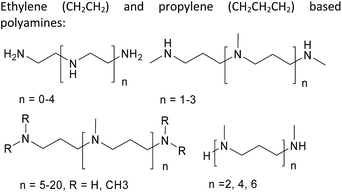 |
K2-SiKat | Polyamines accelerate silicic acid condensation. Siliceous precipitate consist of 200–400 nm in diameter spheres, propylene based polyamines give hollow spheres | 58 and 59 |
| 2 |  |
Na2SiO3 | Spherical particles of 200–300 nm size were obtained at pH 7 (phosphate buffer). Addition of the enzymes (proteases) to the systems resulted in their encapsulation | 60 |
| 3 |  |
TMOS | Spherical composite particles were obtained. Particle size increased up to 900 nm when phosphate buffer was applied | 61 and 62 |
| 4 |  |
Na2SiO3 | Polymer accelerates condensation at pH 5.5–10 giving rise to soluble composite nanoparticles or composite precipitates depending on polymer![[thin space (1/6-em)]](https://www.rsc.org/images/entities/char_2009.gif) : :![[thin space (1/6-em)]](https://www.rsc.org/images/entities/char_2009.gif) Si ratio. Long chain polymeric fraction (polymerization degree 11 Si ratio. Long chain polymeric fraction (polymerization degree 11![[thin space (1/6-em)]](https://www.rsc.org/images/entities/char_2009.gif) 000) gives core–shell particles consisting of one macromolecule and several 3–6 nm silica particles in the core 000) gives core–shell particles consisting of one macromolecule and several 3–6 nm silica particles in the core |
63 and 64 |
| 5 |  |
TMOS | Composite nanoparticles were found in the solution during condensation. Changing of citrate buffer with phosphate results in increase of diameter of soluble particles (from 5 to 120 nm) and size of spherical particles in precipitate (from 170 to more than 2500 nm). Condensation at pH 6 resulted in smoother surface of the particles than at pH 7. Amorphous silica fiber-like structures 100 nm in diameter were obtained under externally applied shear (stirring the reaction mixture and (b) flowing Through a 1/8 in. Tube) | 65–70 |
| 6 | Addition of cationic surfactant N-cetyl-N,N,N-trimethyl ammonium bromide decrease size of the obtained insoluble particles from 3000 to 45–80 nm | 71 | ||
| 7 | The polymer did not influence considerably on the rate of Si(OH)4 condensation at pH 5.5–6 but can interact with silica nanoparticles, especially in the presence of phosphate buffer | 72 | ||
| 8 | Na2SiO3 | Reaction at pH 8.5 resulted in accelerating of condensation and gel formation. The obtained product contains 20% of PAAm | 73 | |
| 9 | K2-SiKat pH 6.8 | Polymer does not influence on the condensation at pH 6.8 in undersaturated solutions of silicic acid (<2–3 mM) and accelerates dissolution of preliminary condensed siliceous particles | 74 | |
| 10 | THEOS | In the presence of phosphate buffer, composite spheres of 300–3000 nm in diameter were obtained. | 75 | |
| 11 | Na2SiO3 | 60–80 nm particles were precipitated at pH 7 (without buffer). Reaction in the presence of model drug (ibuprofen) resulted in drug-loaded particles | 76 | |
| 12 | TMOS | Polymer produced aggregates with trisodium citrate and after silicification monodisperse 40–100 nm composite particles with a high zeta potential (around +20 mV) were obtained | 77 | |
| 13 | Na2SiO3 | Turbidimetry study of silica precipitation under the action of polymer depending on pH and concentration | 78 | |
| 14 | Various polyamines and amine-containing substances | Na2SiO3 | Precipitates were obtained at pH 5–9. Adding of various enzymes to the reaction mixture allowed to obtain immobilized products | 79 |
| 15 |  |
Na2SiO3 | Interpolymeric complex from organic polymers was silicified with Si(OH)4, pH 3 or 8. The technology allows 3D printing with submicrometer resolution | 80 |
| 16 |  |
Na2SiO3 | Composite materials of various morphologies were obtained at pH 9.4. Polymer content was about 25%. Composites can reduce metal ions (NaAuCl4 and Na2PtCl4) giving rise to 2–3 nm metal clusters tightly located on the silica without elimination even after sonication. | 81 |
| 17 |  |
K2-SiKat | The initial rate of condensation increase under the action of polymer at pH 6.8, the maximum increase was observed for 106 kDa fraction. The acceleration is explained with partial protonation of the polymer. Composite precipitate consists of aggregated submicrometer particles. Polymer![[thin space (1/6-em)]](https://www.rsc.org/images/entities/char_2009.gif) : :![[thin space (1/6-em)]](https://www.rsc.org/images/entities/char_2009.gif) silica ratio in precipitates drops from 3.16 to 0.31 when the reaction time changed from 4 h to 7 days silica ratio in precipitates drops from 3.16 to 0.31 when the reaction time changed from 4 h to 7 days |
82 |
| 18 | Na2SiO3 | Polymer inhibits silicic acid condensation after oligomeric PSA is formed. Polymer fractions of MM ≥ 100 kDa give stable solutions of composite nanoparticles while shorter chains create composite precipitates. Increase of silicon![[thin space (1/6-em)]](https://www.rsc.org/images/entities/char_2009.gif) : :![[thin space (1/6-em)]](https://www.rsc.org/images/entities/char_2009.gif) imidazole ratio > 1.5 results in precipitates for all polymer fractions imidazole ratio > 1.5 results in precipitates for all polymer fractions |
83–85 | |
| 19 | 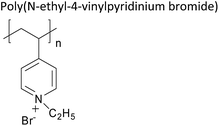 |
Sol of PSA Na2SiO3 | Insoluble polymer–PSA complexes were formed at pH 7–9 and soluble complexes were observed at pH 3. Using of silicic acid instead of PSA results in higher content of silicon in soluble complexes | 86 and 87 |
| 20 | 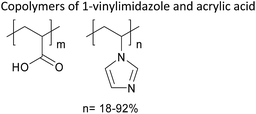 |
Na2SiO3 | Inhibitory action of organic polymers on the condensation was found for copolymers containing more than 44% of imidazole units. This effect is connected with deactivating of silanol groups of primary silica nanoparticles in complexing with copolymers. Condensation of silicic acid in the presence of copolymers results in formation of stable soluble nanoparticles of 20–30 nm in radius. These nanoparticles are negatively charged and their interaction with positively charged composite particles based on poly(vinyl amine) results in fibrous composite material | 64 and 85 |
| 21 |  |
Na2SiO3 | Mesoporous silica were prepared using PEG as a templating agent. The material was applied as desiccant for dehumidification of cooling systems | 88 |
| 22 |  |
Na2SiO3 | Polymer was added to solutions obtained by acidification of sodium silicate solution with HCl (pH = 1–2) following with action of a cation-exchange resin. Transparent and flexible hybrid films were obtained after gelation at 45 °C | 18 |
| 23 | 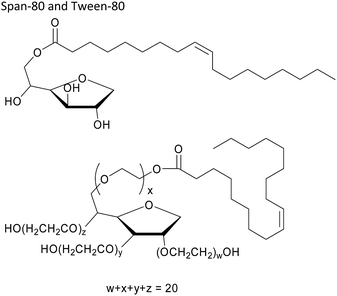 |
Water glass | Mesoporous silica microspheres for delivering poorly water-soluble drugs were prepared by silicic acid condensation in oil emulsion | 89 |
| 24 |  |
Sol PSA | Insoluble polymer–PSA complexes were formed at pH 7–9 and soluble complexes (Rg = 24 nm) were observed at pH 3. The solubility was observed up to 50% of polymeric units interacted with PSA by ionic bonds | 90–92 |
| 25 |  |
Na2SiO3 | Particles of 30–800 nm in diameter were obtained when pH changed from 6.6 to 8.1 | 93 |
| 26 |  |
TMOS | Composite porous particles of 50 nm diameter with positive ζ-potential at pH 7 were obtained | 94 |
| 27 | 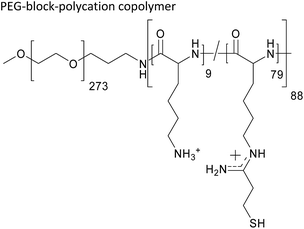 |
Na2SiO3 | Polymer polyplex with siRNA was obtained and silicified pH 7.4 (HEPES buffer). The obtained 100–140 nm particles were used for siRNA delivery | 95 |
| 28 | 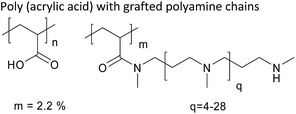 |
Na2SiO3 | The polymer accelerate condensation at pH 5.5 gives rise to soluble composite nanoparticles (170–190 nm in diameter). According to TEM data, polymer and silica are uniformly distributed in these particles. Sedimentation-induced concentration (50![[thin space (1/6-em)]](https://www.rsc.org/images/entities/char_2009.gif) 000g) results in precipitate with reduced amount of polymer (<4%) 000g) results in precipitate with reduced amount of polymer (<4%) |
96 |
| 29 | Polystyrene latexes modified with ∼NH2 and ∼COO− groups | Na2SiO3 | 100–200 nm core–shell particles were obtained at pH 9.7. Hollow particles were obtained with calcination. Slow drying of the particles on a surface resulted in highly organized hexagonal lattices. | 97 |
| 30 |  |
Na2SiO3 | The thermo- and pH-responsive polymer works as a matrix for various siliceous composite structures, including 200–300 nm solid spherical raspberry-like particles and hollow hemispherical particles of more than 1000 nm diameter | 98 |
| 31 | 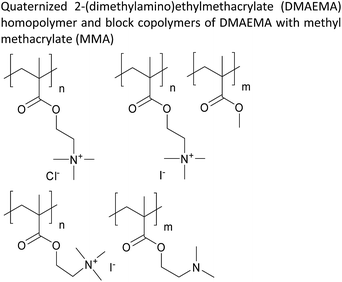 |
Na2SiO3 | The polymers accelerate condensation at pH 7.2 giving precipitates from aggregated ≈100 nm particles. 29Si MAS NMR spectra show increase in condensation degree with increase of quaternization degree | 99 |
| 32 | 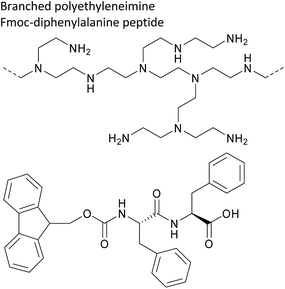 |
Na2SiO3 | Self-organization of the organic components followed by silicification resulted in 800 μm beads which can encapsulate enzyme (epoxide hydrolase SpEH) | 100 |
| 33 |  |
Na2SiO3 | Hollow siliceous particles (1–2 μm) were prepared starting from polystyrene beads. These particles were used in UV blocking applications, such as cosmetics and finishing materials for buildings | 101 |
| 34 | 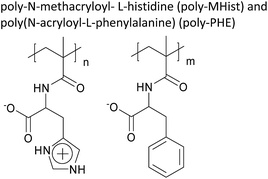 |
Na2SiO3 | Poly-MHist inhibits initial condensation and it is most efficient at pH 7 (where the polymeric chains are neutral) than at pH 5.5 and 8.5. The inhibition effect was not observed after 8 h. The polymer is not found in solid products. Poly-PHE does not influence of the silicic acid condensation | 102 |
| 35 | 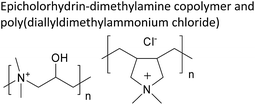 |
Na2SiO3 | Treatment of soil (sand) particles with polymeric cation following with silicification improved the engineering properties of soils | 103 |
| 36 | 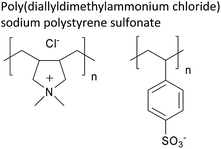 |
TMOS | Yeast cells were treated with polymeric cation and anion followed by encapsulation with silicic acid. The cell viability after 30 days increased >2 times comparing with native cells | 104 |
| 37 | 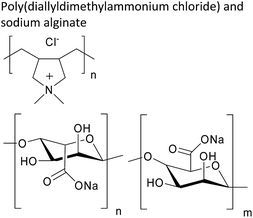 |
Na2SiO3 | Dunaliella tertiolecta cells were encapsulated into hybrid organo-inorganic beads. Photosynthetic activity remained for at least 400 days | 105 |
| 38 |  |
TMOS | 200–400 nm particles were obtained at pH 7 in the presence of phosphate buffer. Poly(allyl amine) addition results in formation of disk-like 100–200 nm structures | 69 and 106 |
| 39 | Precipitation was observed at pH 6.8, 7.5 and 9.2 Tris buffer solutions. Addition of alcohol or carbohydrates resulted in decrease of diameter of spherical products from 540 to 80 nm | 107 | ||
| 40 | 200–1100 nm bimodal distributed particles were obtained at pH 6 and 7 in the presence of phosphate buffer. Particle surface was smoother at pH 6 than at pH 7 | 66 | ||
| 41 | The polymer accelerated condensation in phosphate buffer at pH 7.5 and 11.2. Polymer containing 222 amino acid residues gives hexagonal silica platelet (0.5 and 5 μm) and polymer of 20 units gives spherical 200 nm particles | 108 | ||
| 42 | Hexagonal structures (500–1000 nm) were observed with non-perturbed solutions and passing the solution throw a tube results in petal-like and fiber-like structures | 109 | ||
| 43 | K2-SiKat | Initial condensation rate at pH 6.8 (non-buffered solutions) increased with increase of the oligomer length (2–5 units) and does not change in the case of polymer. Oligomers give 85–140 nm composite particles and polymer – 460 nm | 24 | |
| 44 | Polymer does not influence the condensation at pH 6.8 in undersaturated solutions of silicic acid (<2–3 mM) and accelerates dissolution of preliminary condensed siliceous particles. | 74 | ||
| 45 | THEOS | Spherical (200–400 nm) and hexagonal (400–1000 nm) composite particles were obtained at pH 6.8 (phosphate buffer) | 75 | |
| 46 | Na2SiO3 | Silica was obtained by condensation at pH 5 in pore channels of polycarbonate membranes using preimmobilized poly-L-lysine | 110 | |
| 47 | Poly-L-lysine and poly-D-lysine | TMOS, waterglass | Condensation at pH 7 (phosphate buffer) resulted in hexagonal composite particles (500–2000 nm) due to polymer self-organization. Spherical particles were also observed with poly-D-lysine | 111 |
| 48 | 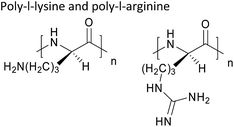 |
Waterglass | Poly-L-lysine accelerated condensation at pH 7.2 (Tris–HCl buffer), increase in the polymer chain length increased the acceleration. Both polymers give composite precipitates containing 50–100 nm particles at pH 7.2 and 9.2, while precipitation was not observed at pH 4.9 | 112 |
| 49 |  |
TMOS | Particles with non-uniform surface were obtained at pH 3.5 (citrate buffer) | 113 |
| 50 |  |
K2-SiKat | Initial condensation rate was slightly decreased at pH 6.8 (without buffer) | 24 |
| 51 |  |
TMOS, waterglass | The polymer precipitates silica at pH 7 (phosphate and phosphate-citrate buffers) in the form of 300–500 or <100 nm spheres in the case of polymers with MW 13 kDa and 55.3 kDa respectively | 114 |
| 52 | Na2SiO3 | Polyarginine formed polyplexes with plasmid DNA and silicic acid was added at pH 7.3 (HEPES buffer) giving rise to Si-coated nanoparticles (114–126 nm in diameter). These particles were used for transfection | 115 | |
| 53 | 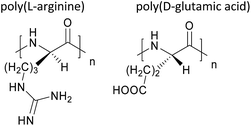 |
Na2SiO3 | Multilayered particles were prepared starting from polymers, histone mimetic H3K4(Me3) tail peptide and GFP plasmid DNA or GFP mRNA. This complex was used for silicic acid condensation (pH 7.4, Tris buffer) and poly-L-arginine was placed on the siliceous surface. The resulted 170 nm particles were used for transfection | 116 |
| 54 |  |
TMOS | Precipitate of aggregated 50 and 150–200 nm spheres was obtained at pH 7 (phosphate buffer) | 117 |
| 55 | K2-SiKat | The polymer accelerates silicic acid condensation at pH 6.8 (without buffer). Composite net-like precipitates contain polymer | 82 | |
| 56 | 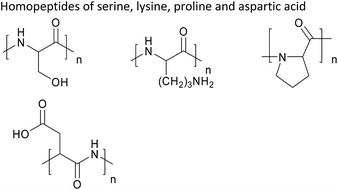 |
Waterglass | Peptides exhibit a stronger catalytic effect on silicic acid condensation than amino acids. Poly-lysine and poly-proline lead to the precipitation of solid phases containing both silica and peptides. The precipitates are formed of agglomerated quasi-spherical particles (diameter <100 nm). Gels prepared in the presence of p-Pro exhibit a rather flat surface, whereas those precipitated in the presence of p-Lys exhibit a more uneven surface | 118 |
| 57 | 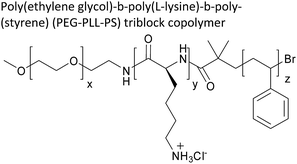 |
TMOS | Condensation at pH 7.5 (phosphate buffer) resulted in Janus hollow silica spheres with hydrophobic PS chains tethered to the inner surface and PEG attached to the outer surface | 119 |
| 58 | β-Casein | Na2SiO3 | 17 nm particles of protein coated with silica were obtained at pH 5.9 (citrate buffer) | 120 |
| 59 |  |
TMOS | Spherical composites (1000 nm aggregates from 15 and 50–200 nm particles) were obtained at pH 5.8 in the presence of phosphate ions | 121 |
| 60 | Na2SiO3 | Manganese peroxidase was immobilized into 100 nm composite particles which protected it from ultrasonic destruction | 122 | |
| 61 | Na2SiO3 | Thermally stable microcapsules as food additives were prepared from soybean oil (core) and composite shell from chitosan and precondensed silicic acid | 123 | |
| 62 |  |
Na2SiO3 | Inhibition of the condensation was observed at pH 7 and 8.33. Composite particles of various sizes were obtained: 100 nm (6 h), 300–500 nm (72 h), aggregates >2000 nm (4 weeks) | 124 |
| 63 | 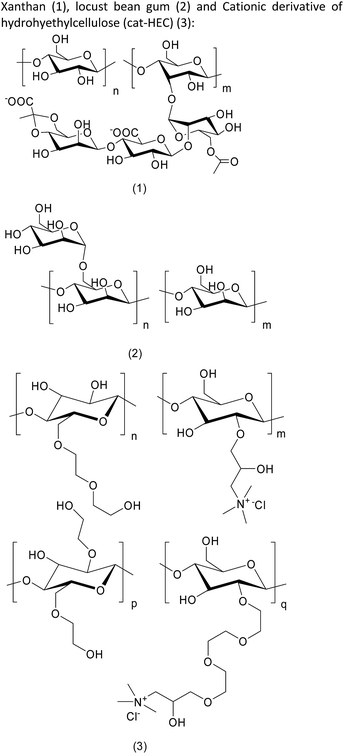 |
THEOS | A composite gel was obtained and used to immobilize enzymes | 125 and 126 |
| 64 | 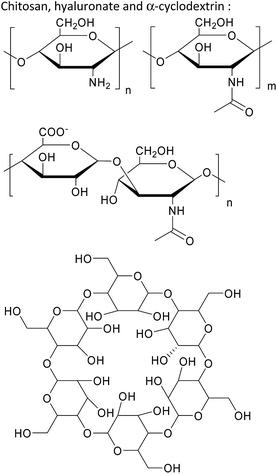 |
THEOS | Hydrogels were obtained at pH 5.5–6 | 127 |
| 65 |  |
THEOS | Formation of composite gels is described | 128 and 129 |
| 66 | 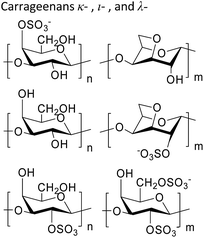 |
THEOS | Polymers promoted the mineralization, acting as a template for the inorganic component. The increase of silicate concentration led to a rise in the stiffness and brittleness of the material, whereas the polysaccharide addition made it softer and more elastic. κ-Carrageenans brought about shrinkage of hybrid materials that led to water separation, while ι- and λ-carrageenans did not induce the syneresis. κ- and ι-carrageenans experienced a thermoreversible phase transition in the hybrid materials owing to the helix–coil transition | 130 |
| 67 | 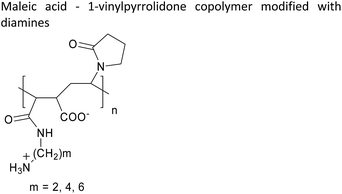 |
TMOS | The copolymers slightly decrease condensation rate at pH 5.5–6 (acetate buffer) and interact with primary PSA particles giving rise to composites | 72 |
| 68 | Polyethyleneimine, polyethylene glycol, chitosan, phosphonomethylated chitosan | Na2SiO3 | Stabilization of soluble silicic acid with these polymers is discussed | 131 |
| 69 | 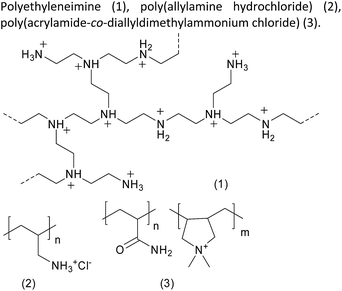 |
Na2SiO3 | Cationic polymers enhance silicate solubility | 132 |
| 70 | 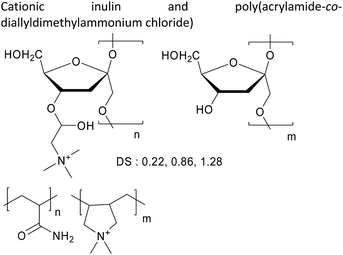 |
Na2SiO3 | Polymers inhibit silicic acid condensation at pH 7 and cationic charge density correlates with inhibitory activity | 133 |
| 71 |  |
Na2SiO3 | Synergistic combinations of cationic and anionic polymers create in situ supramolecular assemblies that can inhibit the condensation of silicic acid. Condensation in the presence of PEG (1.55–20 kDa, pH 7, without buffer) gives rise to spherical particles with maximum diameter near 1000 nm with 6 and 10 kDa samples | 134 and 135 |
| 72 | 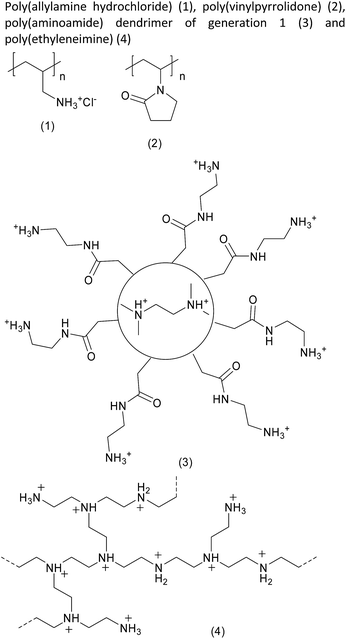 |
Na2SiO3 | The additives accelerate silicic acid polycondensation at pH 5.4 and 7 (without buffer), except for poly(1-vinylpyrrolidone), which shows a minor inhibitory effect | 136 |
| 73 | 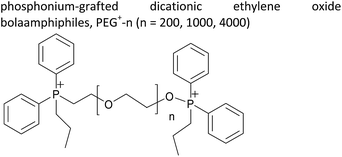 |
Na2SiO3 | PEGP + -200 showed no influence on condensation at pH 7. In the case of PEGP + -1000, and PEGP + -4000, it was found that the inhibitory activity is additive dosage-dependent, demonstrating that there is a clear increase in stabilization ability upon phosphonium PEG dosage increase. The condensation results in spherical particles near 1000 nm | 137 |
| 74 | 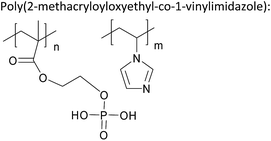 |
Na2SiO3 | Condensation of silicic acid in the presence of the copolymer results in composite particles containing aggregated or non-aggregated copolymer coils with embedded silica | 138 |
| 75 | 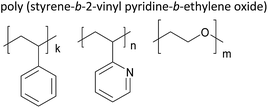 |
TMOS | Silicic acid condensation at pH 4 around polymer micelles results in hollow nanoparticles, the average values of the outer diameter, thickness of the shell, and void diameter are 20, 6, and 11 nm, respectively | 139 |
| 76 |  |
TMOS | Native silaffins induce formation of various siliceous structures, from spherical particles to porous mass at pH 5.5 (acetate buffer). Dephosphorylated silaffins produce insoluble silica in the presence of phosphate ions only | 13 and 140–142 |
| 77 |  |
TMOS | Condensation at pH 6.8 (phosphate buffer) resulted in: 1 – silica spheres (hundreds nanometers) and amorphous silica; 2. – few silica spheres but rather grainy silica structures; 3. – silica spheres (hundreds of nanometers) | 143 |
| 78 |  |
TMOS | Stable solution of 40–70 nm composite particles was obtained after condensation at pH 6.8 (Tris buffer). Phosphate ions induced formation of spherical particles or hexagonal structures when phosphate was added to the composite nanoparticles | 144 |
| 79 |  |
TMOS | A network of fused silica nanoparticles (diameter around 400 nm) is observed at pH 7 (phosphate-citrate buffer) | 145 |
| 80 | 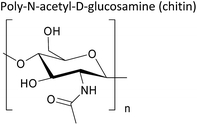 |
Na2SiO3 | Chitin does not influence silicic acid condensation at pH 5.5 (without buffer) but chitin fibers can be silicified | 146 |
| 81 | Type I collagen | K2-SiKat waterglass | Low concentrations of a silicate solution promotes fibril formation at pH 7.4 (Tris buffer). The collagen effect on silicic acid condensation was low | 147 |
| 82 | Silicatein | Na2SiO3 | E. coli was transformed with the silicatein gene. E. coli expressed the silicatein protein which was deposited on the cell surface of the bacteria where it mediates the formation of poly(silicate) after further incubation with monomeric silicic acid | 148 |
| 83 |  |
TMOS | Polyamines do not initiate silica precipitation at pH 5.5 (acetate buffer) but in the presence of acidic peptide silacidin 200–1500 nm spherical particles were obtained | 149 |
| 84 | Peptides corresponded to sequences from silaffins: SKKSGSYSGSKGSKRRIL – R5 (from silaffin-1A1) SSKKSGSYSGYSTKKSGSRRIL – R2 (from silaffin-1A2) SSKKSGSYYSYGTKKSGSYSGYST – R1 (from silaffin-1B) | TMOS, Na2SiO3 | Turbidity was found during silicic acid condensation in the presence of the peptides at pH 7–7.55 (phosphate and phosphate-citrate buffers) SEM showed 100–300 nm composite particles | 69,107 and 150–152 |
| 85 | SSKKSGSYSGSKGSKRRIL (R5 peptide) and n-AEAEAKAKAEAEAKAKSSKKSGSYSGSKGSKRRIL-c - EAK-R5 - chimera consisting of an hydrophobic-polar protein and a silaffin peptide and demonstrated self assembly into hydrogels | TMOS | R5 and EAK-5 initiate silicification at pH 8 (phosphate buffer) giving rise to hydrogels. Particle size was 80–160 and 300–600 nm for EAK-R5 and 320–700 nm for R5 | 153 |
| 86 | Native sericin (protein from cocoons of the silkworm Bombyx mori). Polyserine (MW 3000–10![[thin space (1/6-em)]](https://www.rsc.org/images/entities/char_2009.gif) 000) 000) |
K2-SiKat | The results demonstrate that in aqueous systems, the effect of hydroxyl-containing additives is negligible, although as the molar ratio of the Si/OH groups decreases, the effect of these molecules becomes more apparent (some acceleration of the condensation) | 154 |
| 87 | Chimeras from protein of Nephila clavipes spider silk and R5 peptide | TMOS K2-SiKat | Mineralization in the presence of R5 peptide alone gives silica particles with a size distribution of 0.5–10 μm in diameter, reactions in the presence of the new fusion proteins generate nanocomposite materials containing silica particles with a narrower size distribution of 0.5–2 μm in diameter. The composite morphology and structure could be regulated by controlling processing conditions to produce films and fibers | 155 |
| 88 | Self-assembled α-helical fibers from two α-helical peptides designed to coassemble into a heterodimer. The resulting matured fibers are 50–100 nm thick and tens of micrometers long | Waterglass | Surface of the fibers is positively charged at pH 7.5 which allows the use of the fibers as matrix for silica formation. Proteolysis removes peptides giving the cleanest preparations of silica nanotubes | 156 |
| 89 | R5 peptide and phage peptide clones: SSKKSGSYSGSKGSRRIL – R5 APPGHHHWHIHH – Si3-3 MSASSYASFSWS – Si3-4 KPSHHHHHTGAN – Si3-8 MSPHPHPRHHHT – Si4-1 MSPHHMHHSHGH – Si4-3 LPHHHHLHTKLP – Si4-7 APHHHHPHHLSR – Si4-8 RGRRRRLSCRLL – Si4-10 TVASNSGLRPAS – Ge4-1 | TMOS | R5 peptide gives silica spheres with diameter 500–1000 nm; phage peptide clones form silica nanoparticles with diameter 200–400 nm | 157 |
| 90 | Extracts from horsetail Equisetum telmateia | K2-SiKat | Acceleration of the initial condensation rate at pH 7 in the absence of multiply charged cations, formation of primary 2 nm siliceous particles. | 158 and 159 |
| 91 | Gelatin | Waterglass | Silicate of gelatin forms as a flaky, white and opaque precipitate, when the solution of silicic acid is gradually added to a solution of gelatin in excess. The precipitate is insoluble in water, and is not decomposed by washing. Silicate of gelatin prepared in the manner described, contains 100 silicic acid to about 92 gelatin units | 160–162 |
| 92 | Gelatin and alginic acid | Na2SiO3 | Gelatin activates silica formation at pH = 5, alginic acid does not interfere with silica condensation controls silica morphology through the assembly the gelatin–silica aggregates at the microscale | 163 |
| 93 |  |
Na2SiO3 | Meso–macroporous siliceous materials were prepared using the emulsion template process. Ibuprofen was immobilized on the material as a model drug | 164 |
| 94 |  |
Na2SiO3 | The polymer was used as emulsifier in aqueous medium for octadecane encapsulation into siliceous spherical particles at pH 2.95–3.05 | 165 |
| 95 |  |
Na2SiO3 | The polymer was used as emulsifier in aqueous medium for synthesis of siliceous mesocellular foams using hexane as pore-forming agent | 166 |
| 96 |  |
Na2SiO3 | A mixed solution was dried and dip-coated into 2 M NH4HCO3 solution giving rise to macroporous film | 167 |
(a) The interaction is caused by relatively weak bonds which cannot result in new compounds in the case of monomeric analogs. For example, a weak poly(acrylic acid) can interact with a very weak base poly(1-vinylpyrrolidone) in water solution giving rise to insoluble compound of 1![[thin space (1/6-em)]](https://www.rsc.org/images/entities/char_2009.gif) :
:![[thin space (1/6-em)]](https://www.rsc.org/images/entities/char_2009.gif) 1 stoichiometry:169
1 stoichiometry:169
(b) The interpolymeric reactions are favorable from an entropy point of view comparing with a reaction between small molecules and unusual reactions are possible with polymers, e.g. displacement of strong acid with weak acid:
(c) The cooperative character of the interpolymeric reactions appears in the presence of a minimal critical length of the interacting sequences after which the interaction becomes almost irreversible. The value of critical length depends on the nature of the interacting groups and possible supramolecular effects. For instance, substitution of poly(acrylic acid) with poly(methacrylic acid) in the reaction with polyethylene glycol (PEG) decreases the critical length from ≈100 to ≈20 because of the stabilizing effect arising due to the hydrophobic interactions of the methyl groups from the methacrylic acid moiety.170
(d) The stoichiometry of the interacting polymeric chains is also important, especially in the case of rigid chain polymers and PSA particles which are strengthened due to cross-linking through Si–O–Si bonds.
Thus, organic polymers which bear basic groups can interact with PSA by two ways:
1. Ionic bonds in the case of relatively strong polymeric bases or polymeric cations:
This kind of interaction increases the amount of silanol anions which are active in reaction with unionized monomeric silicic acid and acceleration of Si(OH)4 condensation is observed in neutral and acidic conditions.99,112,118,158,171,172
2. Polymers with weak basic groups interact with PSA particles by forming hydrogen bonds. Multiplicity of these interactions enhances binding and decrease in the number of silanol anions as seen in the silicic acid condensation in the presence of poly(1-vinylimidazole) shown below:
The decrease in ∼Si–O− concentration results in a decrease in the condensation rate.84,85,102 The same effect is probably dominant in the case of poly(N-methacryloyl-L-histidine),102 poly(1-vinylpyrrolidone)136 and PEG.134,135,137
There is a series of reports which contradict these schemes.131,137,173,174 For instance, inhibition of Si(OH)4 condensation is observed for a wide range of polymeric cations and amines. The reason for this contradiction is possibly due to the different procedures employed for measurement of monomeric silicic acid concentration. K. Demadis et al.173 have used the silicomolybdate method provided by the HACH Company175 which allows the measurement of a “soluble” (“reactive”) silica, i.e. short oligomers of unknown length apart from the monomer and dimer molecules. In other reports,124,132–134,176,177 the molybdate procedure employed also has variations from the recommended protocol for measuring monomeric and dimeric forms of silicic acid exclusively.56 Thus, it appears that the visible inhibition of Si(OH)4 condensation with polycations can be explained by the stabilization of oligomeric forms of PSA through their complexation with polymers that prevents further aggregation of these oligomers.178 On the other hand, when a blue molybdenum procedure, elaborated to measure only monomer and dimer of silicic acid is employed,136 the same team reported acceleration of the condensation with polymeric bases. These findings imply the importance of the quantification method employed.
The formation of organic polymer – short PSA oligomer complexes also explain dissolution of silica in the presence of polymers capable of interacting with charged silicate species.74,134,179 According to our view, the same concepts are involved in the inhibition action of adipic acid/amine-terminated polyethers D230/diethylenetriamine copolymer.180 This polymer contains many groups capable of forming hydrogen bonds. Moreover, the addition of polyepoxysuccinic acid increases the inhibition, possibly due to neutralization of amine groups in the copolymer. We must also mention that study of the kinetics of Si(OH)4 condensation requires a strict observance of all protocols, including Si(OH)4 preparation from a precursor. For example, in ref. 24 the authors showed that long neutralization of sodium silicate (during 10 min) can result in formation of primary PSA oligomers and the system becomes more complex with presence of entities other than the desired silicic acid–polymer.
Most reports devoted to the kinetics of Si(OH)4 condensation in the presence of water-soluble polymers demonstrate the influence of polymers on the condensation rate only and the equilibrium Si(OH)4 concentration was 2–3 mM in the siliceous solutions without additives. These values were also observed as when the condensation proceeded with precipitation of silica–polymer composite. We observed181 a decrease of the equilibrium concentration when silicic acid was condensed in the presence of poly(vinyl amine) (PVA) gel containing Zn2+ ions. This gel was able to capture 20% of silicon from 0.1 mM solution which was attributed to the formation of highly stable PVA–PSA complex with participation of zinc ions.
Interaction of polymeric silicic acid with organic polymers in solution
Condensation of silicic acid in the presence of polymers capable of interacting with PSA results in solutions containing composite nanoparticles or various insoluble products. As mentioned in the earlier sections, PSA–polymer complexes are similar to interpolymer complexes of organic polymers. Interaction between two polymers bearing hydrophilic groups gives rise to so-called stoichiometric or non-stoichiometric complexes.182–184 In the first case, all reactive groups, e.g. ∼COOH and ∼NH2 react with each other and all hydrophilic groups become blocked from interaction with water medium which often results in water insolubility. The non-stoichiometric complexes are obtained when one of the components is in deficiency or when some peculiarities of the main polymeric chains do not allow stoichiometric interaction. The free polymeric segments provide solubility of these complexes. Polyampholytes often gives soluble interpolymeric complexes because only one group (basic or acidic) can interact with another polymer. Both variants are observed in PSA–polymer complexes but siliceous systems differ from organic interpolymer complexes because condensation and/or dissociation reactions can proceed during interaction with organic polymer. Thus, Si(OH)4 condensation in the presence of organic polymer includes several parallel processes:1. Silicic acid condensation and growth of siliceous oligomers.
2. Interaction of the siliceous oligomers with organic polymer when the oligomer size will be sufficient for this interaction.
3. Further transformations of the polymer–PSA complex, including sintering of the silica nanoparticles and conformational changes of the organic macromolecules.
Several main factors influence interaction between growing siliceous particles and organic polymers in aqueous medium.
Nature of the polymeric functional groups, pH and ionic strength
As mentioned earlier, the ability of the organic polymer to interact with PSA by means of hydrogen and/or ionic bonds depends on the basicity of functional groups. Certainly, pH, ionic strength and temperature must influence this reaction by changing the critical length of the interacting sequences. This effect was observed with polymeric amines.64,90 Greater protonation of the amine groups at pH 7 compared with pH 9–10 resulted in enhancement of polymer–PSA interactions, larger compaction of the composite nanoparticles in the solution and increase in the precipitation probability. Control of pH in the reaction medium is often achieved using a buffer. In this case, we must take into account that phosphate, citrate and other multivalent anions influence the silicic acid condensation in the presence of polymeric amines resulting in precipitation of composites.65,71 The ability of citrate ion to give aggregates with poly(allylamine) was utilized77 to synthesize monodisperse 40–100 nm composite particles.Length and flexibility of the polymer chain
Growth of siliceous particles during silicic acid condensation proceeds at the same time with interaction with organic polymer and depending on the polymer length at least two situations are possible:1. Polymer chain is long and flexible enough to capture siliceous particle into polymeric coil (Fig. 3A). This results in encapsulation of siliceous particles in organic macromolecules giving rise to soluble composite nanoparticles similar to non-stoichiometric complexes between organic polymers. This behavior was observed for amine containing polymers,112 polymers with imidazole moieties82–84 and polyampholytes.85 Irrespective of the nature of the functional group and ability of the polymer to accelerate or to inhibit Si(OH)4 condensation, composite soluble nanoparticles can be obtained if the polymer units can interact with ∼Si–OH or ∼Si–O− and the chain is sufficiently long and flexible. Clusters of 50–180 nm particles built up from regularly sized particles 7–8 nm in diameter were formed from silicic acid condensation in the presence of horsetail extract (Equisetum telmateia).158 Insoluble cellulose macromolecules can also stabilize 4 nm diameter silica particles.185
2. When the polymer chain is relatively short, a single polymer coil can not consume a siliceous particle and various aggregates are formed (Fig. 3B–D). Depending on the nature of the polymer and the reaction conditions, we can obtain large multiparticle aggregates solubilized with free segments of the polymeric chains (Fig. 3B) or insoluble material with siliceous particles serving as cross-linker for the organic polymer (Fig. 3C). In the latter case, further fusion of the siliceous particles is possible when organic polymer is deficient (Fig. 3D).
Polymer![[thin space (1/6-em)]](https://www.rsc.org/images/entities/h3_char_2009.gif) :
:![[thin space (1/6-em)]](https://www.rsc.org/images/entities/h3_char_2009.gif) Si ratio
Si ratio
Interaction between growing PSA nanoparticles and macromolecular chains often results in stable soluble nanoparticles63,64,85,90–93,95,96,115,116,120,131,132 or in a product consisting of uniform spherical composite particles.24,61,62,65–71,75–77,98,99,106–108,111,112,114,117,121,124,134,135,137,139,143,149,153,155,157 These variants exist in the case of relatively low silicon content in the system, when all PSA nanoparticles can find chains of organic polymer. Further increase in the silicic acid content results in formation of insoluble non-uniform products64,83 because of cross-linking by means of silicic acid which was condensed independent of the polymer control.
Biosilicification: how living cell can control silica formation?
Discovery of silaffins12,13,140–142 – proteins with post-translational phosphate and polyamine modifications (Table 1, # 73) intensified research focused on investigating silicic acid condensation in the presence of polymeric bases and ampholytes. Silaffins are associated with siliceous frustules of diatoms and the hypothesis of biogenic silica growth around matrix of silaffins was formulated.140,141,143 Unfortunately, silaffins can be isolated from diatom frustules in microgram quantities only which is not sufficient for study of their properties including their influence on silicic acid condensation. Hence, synthetic organic polymers can serve as a good model of silaffins. On the other hand, introduction of organic polymers into nonaqueous sol–gel systems is a well-known strategy to obtain interesting composite materials.27,186–188 Thus Si(OH)4 condensation regulated by water soluble polymers is expected to result in new bioinspired materials.On analyzing the reported data on silicic acid–polymer systems (Table 1), we found two peculiarities which distinguish synthetic products from diatom frustules (Fig. 1A and B). The precipitates obtained during silicic acid condensation in the presence of organic polymer do not have regular organization at the level of several microns. The usual spherical morphology of these products are often found associated as a continuous structure. The observations of organized structures in some reports144,189 can be attributed as a sampling artifact because the samples for microscopy were prepared by air-drying of wet precipitates. We showed85 that air-drying of composite precipitates can result in self-organization of the particles into highly ordered structures in which the morphology is very distinct from the initial particles precipitated from solution. Self-association under slow drying gives highly organized hexagonal lattices from monodisperse 100–200 nm siliceous particles.97 Composite precipitates obtained using an organic polymer contain the polymer in significant amount (≥10%) but the siliceous frustules of diatoms contain <5% of organic compounds,190,191 and this organic material are not only from silaffins. Moreover, thorough cleaning of diatom frustules decreases carbon content below 0.2%.190
PSA nanoparticles or oligomers stabilized with biopolymers are the most probable form of silicon in diatoms and similar silicifying organisms.24,64,144 So, a mechanism of conversion of these composite nanoparticles to almost clear silica must exist. This mechanism must be genetically controlled with the object to provide a large diversity of species-specific frustules. A possible mechanism for such control from the cell is desiccation under the action of aquaporines.11 This hypothesis includes transport of aquaporines to specified places on the membrane of silica deposition vesicle (SDV) by means of cytoskeleton. SDV contains the precursor of silica (composite nanoparticles) and the aquaporines function as specific pores which pump water out of SDV. Removal of water results in increase of silica precursor concentration which then initiates condensation of soluble composite nanoparticles to solid silica. The question that arises here is: can this desiccation-induced condensation produce silica without large content of organic substances? We have done a model experiment with polyampholyte containing polyamine sidechains.96 Desiccation was simulated by centrifugation at 50![[thin space (1/6-em)]](https://www.rsc.org/images/entities/char_2009.gif) 000g which concentrated the composite organo-silica particles at the bottom of the centrifuge tube. We found formation of precipitate from 100–200 nm sintered particles. The precipitate contained 4% of organic polymer which is closer to biosilica than usual composites obtained from silicic acid and organic polymers. Thus, we hypothesize that silaffins function as stabilizing agents of PSA in diatoms and during desiccation-induced condensation a major part of organic polymer is eliminated from the solid material. A possible scheme of the biosilica synthesis is presented on Fig. 4.
000g which concentrated the composite organo-silica particles at the bottom of the centrifuge tube. We found formation of precipitate from 100–200 nm sintered particles. The precipitate contained 4% of organic polymer which is closer to biosilica than usual composites obtained from silicic acid and organic polymers. Thus, we hypothesize that silaffins function as stabilizing agents of PSA in diatoms and during desiccation-induced condensation a major part of organic polymer is eliminated from the solid material. A possible scheme of the biosilica synthesis is presented on Fig. 4.
Application areas of the new knowledge in silicic acid condensation
Study of silicic acid condensation in the presence of water-soluble polymers is related to processes in solution and to formation of solid substances. Both areas provide valuable information for practical applications.The ability of organic polymers to stabilize PSA in an easily hydrolysable form is the basis of water treatment applications. Polymers of silicic acids are the cause of detrimental precipitates in industrial and domestic water flow systems. The addition of various polymers capable of interacting with PSA prevents the precipitation.131,134,192–194
The soluble composite nanoparticles could be considered as new biomimetic precursors for the synthesis of more complex siliceous structures. These nanoparticles bear negative or positive charge depending on the nature of the organic polymer and can interact with oppositely charged objects. For instance, poly(allyl amine)-based composite nanoparticles formed hexagonal structures when phosphate ions were added to the solution.144 Positively charged nanoparticles obtained by Si(OH)4 condensation in the presence of poly(vinyl amine) reacted with negative composite nanoparticles obtained with poly(1-vinylimidazole-co-acrylic acid) giving rise to a fibrous material containing 40–50% of SiO2.64
The ability of PSA particles to interact with polymeric amines was employed85,195 to create silicified materials by means of direct ink writing with 3D-printers. These studies are based on bioinspired concepts using matrix-assisted condensation of silicic acid.
A major application of silicification in aqueous medium is the encapsulation of biologically active substances,76,95,115,116,120,196 including drug delivery.197 The siliceous shell is usually formed around a complex of polymeric cation and encapsulated moiety, e.g. nucleic acid in transfection applications. The obtained particles with sizes typically below 200 nm serve as delivery agents, and can release the drug or internalize into the cell following the destruction of the siliceous shell. Silicic acid condensation in the presence of positively charged surfaces opens new vistas for silicification of relatively large objects such as living cells104,105,148 which retain viability longer than native cells. Islet cell encapsulation in a siliceous layer has been found to be beneficial to extend the survival of the cells. Enzyme encapsulation in siliceous shells is another promising strategy to design highly effective catalysts. Enzymes in free state are homogenous catalysts with disadvantages of low life time, poor stability and large difficulties in separation from the reaction products. Silicic acid condensation in the presence of polymeric bases and enzymes gives rise to particles containing the enzyme80,100,122 which retains its catalytic activity. The siliceous layers protect the enzyme from undesirable factors and helps to separate the catalyst from the reaction medium through sedimentation. This approach is protected with an extensive patent.79 Particles obtained from silicic acid and polymeric bases can also capture other substances, e.g. soybean oil.123
Silicic acid condensation around cationic spherical matrix is a convenient way to obtain hollow particles of various sizes, from hundreds of nanometers to micrometers. The hollow siliceous particles can be applied as containers in drug delivery, as plastic fillers and in design of complex microdevices. Assembly of these particles can commence from organic beads obtained by emulsion polymerization of styrene following with amination of the beads, silicic acid condensation around beads and calcination to remove the organic polymer (Fig. 5A).97,101 A solid matrix in the form of porous membrane was applied for synthesis of silica microtubes.110 The alternative one-step approach to obtain hollow particles involves silicic acid condensation around self-organized low molecular polyamines (Fig. 5B).58 The latter method avoids the calcination stage and hence facilitates recycling of the matrix. A similar approach was applied for assembly of core–shell and hollow particles from zein (a major storage protein from corn Zea mays).198
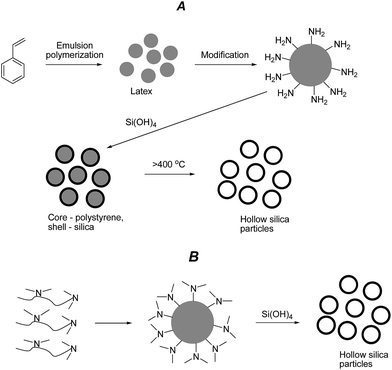 | ||
| Fig. 5 Schemes of latex-templated synthesis of hollow siliceous particles (A) and silicification on self-organized nano-droplet from low-molecular polyamines (B). | ||
Composite submicrometer particles obtained in aqueous medium can be loaded with a fluorescent dye and applied as liquid flow tracers.97
The main part of siliceous composite materials is prepared from organic precursors of silicic acid. Sodium silicate is attractive because it is a cheap and ecology-friendly substance comparing to alkoxysilanes. Mesoporous forms of silica based on an amine surfactant as the structure-directing porogen were prepared and used as reinforcing and toughening agents for epoxy polymers.199 The material obtained from sodium silicate showed smaller framework pore sizes (4–5 nm) comparing with TEOS-based silica (6–21 nm) and provided exceptional strength and toughness.
Introduction of organic polymers, e.g. poly(ethylene oxide)–poly(propylene oxide)–poly(ethylene oxide) triblock copolymer into siliceous gel on the condensation stage results in highly ordered mesoporous structures and pore sizes in the range from 7.5 to 10 nm.200
Silicic acid and its oligomers act as cross-linking agents during polymerization of acrylic acid or acrylamide.201 The obtained material can be applied as environmentally-friendly superabsorbent because the crosslinking bonds ![[triple bond, length as m-dash]](https://www.rsc.org/images/entities/char_e002.gif) Si–O–(O
Si–O–(O![[double bond, length as m-dash]](https://www.rsc.org/images/entities/char_e001.gif) )C– are hydrolysable and the sorbent dissolves after several days after application.
)C– are hydrolysable and the sorbent dissolves after several days after application.
Porous materials were obtained by condensation in the presence of PEG88,164 or similar surfactants and emulsifiers such as Span-80 and Tween-80.89 Condensation in the presence of water-insoluble substance, e.g. octadecane, results in the substance encapsulation with a smooth and compact silica surface165 and in the case of hexane siliceous mesocellular foams were obtained.166 Organo-silica composites can be applied for synthesis of highly ordered carbon materials by dissolution of silica in hydrofluoric acid. This approach allowed to obtain highly nitrogen doped mesoscopic carbons which show high electrocatalytic activity.202,203
Conclusion: future prospects in Si(OH)4–polymer systems
Silicic acid condensation in the presence of water-soluble polymers is a dynamically developing area and several important points come to the fore:(a) Development of methods to study silicic acid condensation in solution where the traditional molybdate method must be re-examined and standardized with the objective to ensure that the obtained data correspond to monomeric and dimeric forms of Si(OH)4. This is possible with the use of 29Si NMR spectrometry and isotope-enriched silicic acid. A promising and widely-spread method which allows to distinguish various forms of condensed Si(OH)4 is attenuated total reflection Fourier transform infrared (ATR-FTIR) spectroscopy, including multiple reflection approach. This method requires a special study devoted to the band assignment in water medium in comparison with 29Si NMR data. Soluble nanoparticles formed under silicic acid condensation are difficult systems for study. Light scattering methods are often not sensitive enough for siliceous phase while electron microscopy is complicated and associated with aggregation during sample preparation. So, new approaches are needed in this area, including unusual techniques such as laser ablation combined with aerosol spectrometry.64
(b) Simulation of biosilicification where the reaction in aqueous medium is an adequate model to study behavior of silicic acid in living organisms. The accumulated knowledge allows to approach synthesis of artificial silica with structures similar to biogenic silica. On the other hand, mimicking the silica biosynthesis must include simulation of the cell structures participating in this process on a micrometer level, e.g. membranes bearing active domains, because the transition from partially condensed silicic acid coordinated with organic polymer to organized solid silica structures is an important but poorly understood process. The in vitro experiments do not exclude study of living cells like diatoms, sponges, cell cultures of higher organisms. Further progress in this area is expected from coupling of modern equipment with specially designed tracers including fluorescent or spin probes, e.g. tagged silicic acid.
(c) New materials for encapsulation of biologically active compounds into silica or composite particles that opens new possibilities for drug delivery and design of prolonged action preparations. Self-organized water soluble nanoparticles are an attractive option that has emerged from the investigations on silicic acid condensation processes. These particles combine rigidity of siliceous structure with variable functionality of organic polymer. Reversible drying of this nanoparticles is a large challenge for chemists because the presence of active silanol groups provokes aggregation and condensation under usual freeze drying. Elaboration of the novel drying techniques will result in new drug formulations and can solve the problem of the cold chain with preparations containing protein or nucleic acid.
(d) New organic polymers can be developed as further progress in construction of siliceous nanocomposites requires new functional polymers with easily tunable structure, including functionality and the chain length. We can expect involvement of “smart” polymers showing thermo- and pH-sensitivity for the design of “smart” composites.
Acknowledgements
We acknowledge financial support from a joint grant of the Russian Science Foundation (# 16-45-02001) and the Department of Science Technology of the Ministry of Science and Technology of the Republic of India (# INT/RUS/RSF/10).Notes and references
- C. C. Perry and T. Keeling-Tucker, J. Biol. Inorg Chem., 2000, 5, 537–550 CrossRef CAS PubMed.
- P. Treguer, D. M. Nelson, A. J. Van Bennekom, D. J. Demaster, A. Leynaert and B. Queguiner, Science, 1995, 268, 375–379 CAS.
- R. Gordon, D. Losic, M. A. Tiffany, S. S. Nagy and F. A. S. Sterrenburg, Trends Biotechnol., 2009, 27, 116–127 CrossRef CAS PubMed.
- J. W. Blunt, B. R. Copp, R. A. Keyzers, M. H. G. Munro and M. R. Prinsep, Nat. Prod. Rep., 2013, 30, 237–323 RSC.
- M. J. Uriz, X. Turon, M. A. Becerro and G. Agell, Microsc. Res. Tech., 2003, 62, 279–299 CrossRef CAS PubMed.
- L. E. Datnoff and F. A. Rodrigues, The role of silicon in suppressing rice diseases, APSnet Features, 2005 DOI:10.1094/APSnetFeature-2005-0205.
- A. K. da Silva Lobato, E. M. Silva Guedes, D. J. Marques and C. F. de Oliveira Neto, in Responses of organisms to water stress, ed. S. Akinci, InTech, Rijeka, Croatia, 2013, pp. 95–113 Search PubMed.
- C. He, L. Wang, X. Liu, J. Ma, Y. Lin and F. Xu, New Phytol., 2013, 200, 700–709 CrossRef CAS PubMed.
- O. Ueno and S. Agarie, Plant Prod. Sci., 2005, 8, 71–73 CrossRef.
- C. Exley, Front. Plant Sci., 2015, 6, 853 Search PubMed.
- M. A. Grachev, V. V. Annenkov and Y. V. Likhoshway, BioEssays, 2008, 30, 328–337 CrossRef CAS PubMed.
- N. Kroger, R. Deutzmann and M. Sumper, Science, 1999, 286, 1129–1132 CrossRef CAS PubMed.
- N. Kroger, S. Lorenz, E. Brunner and M. Sumper, Science, 2002, 298, 584–586 CrossRef PubMed.
- J. N. Cha, K. Shimizu, Y. Zhou, S. C. Christiansen, B. F. Chmelka, G. D. Stucky and D. E. Morse, Proc. Natl. Acad. Sci. U. S. A., 1999, 96, 361–365 CrossRef CAS.
- T. Coradin and J. Livage, Acc. Chem. Res., 2007, 40, 819–826 CrossRef CAS PubMed.
- R. Schwarz and W. D. Muller, Z. Anorg. Allg. Chem., 1958, 296, 273–279 CrossRef CAS.
- I. D. Shcher+ban, Dokl. Akad. Nauk USSR, 1967, 177, 1200–1203 Search PubMed.
- T. Kotoky and S. K. Dolui, J. Sol-Gel Sci. Technol., 2004, 29, 107–114 CrossRef CAS.
- R. Iler, The Chemistry of Silica, Wiley, New York, 1982 Search PubMed.
- E. Weitz, H. Franck and M. Schuchard, Chem.-Ztg., 1950, 74, 256–257 CAS.
- R. Schwartz and K. G. Knauff, Z. Anorg. Allg. Chem., 1954, 275, 176–192 CrossRef.
- D. F. Evans, J. Parr and E. N. Coker, Polyhedron, 1990, 9, 813–823 CrossRef CAS.
- C. C. Harrison and N. Loton, J. Chem. Soc., Faraday Trans., 1995, 91, 4287–4297 RSC.
- D. Belton, G. Paine, S. V. Patwardhan and C. C. Perry, J. Mater. Chem., 2004, 14, 2231–2241 RSC.
- R. C. Mehrotra and R. P. Narain, Indian J. Chem., 1967, 5, 444–447 CAS.
- M. Meyer, A. Fischer and H. Hoffmann, J. Phys. Chem. B, 2002, 106, 1528–1533 CrossRef CAS.
- J. Brinker and G. W. Scherer, Sol-gel science: the physics and chemistry of sol-gel processing, Academic Press, London, 1990 Search PubMed.
- D. J. Belton, O. Deschaume and C. C. Perry, FEBS J., 2012, 279, 1710–1720 CrossRef CAS PubMed.
- T. Tarutani, Anal. Sci., 1989, 5, 245–252 CrossRef CAS.
- G. R. Choppin, P. Pathak and P. Thakur, Main Group Met. Chem., 2008, 31, 53–72 CrossRef CAS.
- D. J. Belton, O. Deschaume, S. V. Patwardhan and C. C. Perry, J. Phys. Chem. B, 2010, 114, 9947–9955 CrossRef CAS PubMed.
- J. Tamahrajah and A. Brehm, Mar. Chem., 2016, 181, 18–24 CrossRef CAS.
- E. R. Pohl and F. D. Osterholtz, in Molecular characterization of composite interfaces, ed. H. Ishida and G. Kumar, Plenum Press, New York, 1985, pp. 157–170 Search PubMed.
- C. G. Swain, R. M. Esteve and R. H. Jones, J. Am. Chem. Soc., 1949, 71, 965–971 CrossRef CAS PubMed.
- W. T. Grubbs and A. Rate, J. Am. Chem. Soc., 1954, 76, 3408–3414 CrossRef.
- C. Okkerse, in Physical and chemical aspects of adsorbents and catalysts, ed. B. G. Linsen, Academic Press, London and New York, 1970, pp. 214–264 Search PubMed.
- L. P. Davis and L. W. Burggraf, in Ultrastructure processing of advanced ceramics, ed. J. D. Mackenzie and. D. R. Ulrich, Wiley, New York, 1988, pp. 367–378 Search PubMed.
- E. P. Flint and L. S. Wells, J. Res. Natl. Bur. Stand., 1934, 12, 751–783 CrossRef CAS.
- P. S. Roller and G. J. Ervin, J. Am. Chem. Soc., 1940, 62, 461–471 CrossRef CAS.
- A. F. Joseph and H. B. Oakley, J. Chem. Soc., 1925, 127, 2813–2818 RSC.
- W. D. Treadwell and W. Wieland, Helv. Chim. Acta, 1930, 13, 842–864 CrossRef CAS.
- G. Hagg, Z. Anorg. Allg. Chem., 1926, 155, 21–41 CrossRef CAS.
- D. R. Lide, CRC Handbook of chemistry and physics, 2009−2010, 90th ed, CRC Press, Boca Raton, 2009 Search PubMed.
- S. Sjöberg, Y. Hägglund, A. Nordin and N. Ingri, Mar. Chem., 1983, 13, 35–44 CrossRef.
- J. P. Hershey and F. J. Millero, Mar. Chem., 1986, 18, 101–105 CrossRef CAS.
- P. Schindler and H. R. Kamber, Helv. Chim. Acta, 1968, 51, 1781–1786 CrossRef CAS.
- F. Ordway, Science, 1964, 143, 800–801 CAS.
- P. W. J. G. Wijnen, T. P. M. Beelen and R. A. van Santen, in The colloid chemistry of silica, American Chemical Society, ed. H. E. Bergna, Washington, 1994, pp. 517–531 Search PubMed.
- W. Ostwald, Lehrbuch der Allgemeinen Chemie, Leipzig, Germany, 1896 Search PubMed.
- W. Ostwald, Z. Phys. Chem., 1897, 22, 289–330 CAS.
- H. Jolles and F. Neurath, Angew. Chem., 1898, 11, 315–316 CrossRef.
- J. D. H. Strickland, J. Am. Chem. Soc., 1952, 74, 862–867 CrossRef CAS.
- M. Takahashi, Y. Abe and M. Tanaka, Talanta, 2015, 131, 301–308 CrossRef CAS PubMed.
- J. B. Mullen and J. P. Riley, Anal. Chim. Acta, 1955, 12, 162–176 CrossRef.
- R. J. Volk and R. L. Weintraub, Anal. Chem., 1958, 30, 1011–1014 CrossRef CAS.
- T. Coradin, D. Eglin and J. Livage, Spectroscopy, 2004, 18, 567–576 CrossRef CAS.
- X. Yang, P. Roonasi and A. Holmgren, J. Colloid Interface Sci., 2008, 328, 41–47 CrossRef CAS PubMed.
- D. J. Belton, S. V. Patwardhan, V. V. Annenkov, E. N. Danilovtseva and C. C. Perry, Proc. Natl. Acad. Sci. U. S. A., 2008, 105, 5963–5968 CrossRef CAS PubMed.
- V. V. Annenkov, S. V. Patwardhan, D. J. Belton, E. N. Danilovtseva and C. C. Perry, Chem. Commun., 2006, 14, 1521–1523 RSC.
- P. J. Baker, S. V. Patwardhan and K. Numata, Macromol. Biosci., 2014, 14, 1619–1626 CrossRef CAS PubMed.
- N. Kröger, R. Deutzmann, C. Bergsdorf and M. Sumper, Proc. Natl. Acad. Sci. U. S. A., 2000, 97, 14133–14138 CrossRef PubMed.
- M. Sumper, S. Lorenz and E. Brunner, Angew. Chem., Int. Ed., 2003, 42, 5192–5195 CrossRef CAS PubMed.
- V. V. Annenkov, E. N. Danilovtseva, V. O. Aseyev, S. V. Patwardhan and C. C. Perry, in IASTED International Conference on Nanotechnology and Applications, Crete, Greece, 2008 Search PubMed.
- V. V. Annenkov, E. N. Danilovtseva, V. A. Pal'shin, V. O. Aseyev, A. K. Petrov, A. S. Kozlov, S. V. Patwardhan and C. C. Perry, Biomacromolecules, 2011, 12, 1772–1780 CrossRef CAS PubMed.
- E. Brunner, L. Lutz and M. Sumper, Phys. Chem. Chem. Phys., 2004, 6, 854–857 RSC.
- S. V. Patwardhan and S. J. Clarson, Mater. Sci. Eng., C, 2003, 23, 495–499 CrossRef.
- S. V. Patwardhan and S. J. Clarson, Polym. Bull., 2002, 48, 367–371 CrossRef CAS.
- S. V. Patwardhan, N. Mukherje and S. J. Clarson, Silicon Chem., 2002, 1, 47–54 CrossRef CAS.
- S. V. Patwardhan and S. J. Clarson, J. Inorg. Organomet. Polym., 2002, 12, 109–116 CrossRef CAS.
- S. V. Patwardhan, N. Mukherje and S. J. Clarson, J. Inorg. Organomet. Polym., 2001, 11, 117–121 CrossRef CAS.
- G. Begum, R. K. Rana, Sh. Singh and L. Satyanarayana, Chem. Mater., 2010, 22, 551–556 CrossRef CAS.
- V. V. Annenkov, E. N. Danilovtseva and I. N. Kotel'nikov, Polym. Sci., Ser. A, 2008, 50, 147–152 CrossRef.
- T. Mazutani, H. Nagase, N. Fugiwara and H. Ogoshi, Bull. Chem. Soc. Jpn., 1998, 71, 2017–2022 CrossRef.
- S. V. Patwardhan, G. E. Tilburey and C. C. Perry, Langmuir, 2011, 27, 15135–15145 CrossRef CAS PubMed.
- S. V. Patwardhan, C. Raab, N. Hüsing and S. J. Clarson, Silicon Chem., 2005, 2, 279–285 CrossRef CAS.
- S. Davidson, D. A. Lamprou, A. J. Urquhart, M. H. Grant and S. V. Patwardhan, ACS Biomater. Sci. Eng., 2016, 2, 1493–1503 CrossRef CAS.
- V. S. Murthy, T. G. Belgard and M. S. Wong, US Pat. 20100222501, 2010.
- A. Jantschke, K. Spinde and E. Brunner, Beilstein J. Nanotechnol., 2014, 5, 2026–2035 CrossRef PubMed.
- R. Bond, M. C. Jewett, J. C. McAuliffe and D. E. Ward II, US Pat. 7642077, 2010.
- M. J. Xu, G. M. Gratson, E. B. Duoss, R. F. Shepherd and J. A. Lewis, Soft Matter, 2006, 2, 205–209 RSC.
- P.-X. Zhu and R.-H. Jin, J. Mater. Chem., 2008, 18, 313–318 RSC.
- M. K. Liang, S. V. Patwardhan, E. N. Danilovtseva, V. V. Annenkov and C. C. Perry, J. Mater. Res., 2009, 24, 1700–1708 CrossRef CAS.
- V. V. Annenkov, E. N. Danilovtseva, E. A. Filina and Y. V. Likhoshway, J. Polym. Sci., Part A: Polym. Chem., 2006, 44, 820–827 CrossRef CAS.
- V. V. Annenkov, E. N. Danilovtseva, Y. V. Likhoshway, S. V. Patwardhan and C. C. Perry, J. Mater. Chem., 2008, 18, 553–559 RSC.
- E. N. Danilovtseva, V. A. Pal’shin, Y. V. Likhoshway and V. V. Annenkov, Adv. Sci. Lett., 2011, 4, 616–621 CrossRef CAS.
- L. N. Yermakova, Yu. G. Frolov, V. A. Kasaikin, A. B. Zezin and V. A. Kabanov, Polym. Sci. U.S.S.R., 1981, 23, 2529–2544 CrossRef.
- V. Yu. Baranovsky, S. A. Suchishvili, V. A. Kasaikin and V. A. Kabanov, Eur. Polym. J., 1993, 29, 111–114 CrossRef CAS.
- H. Setyawan, M. Yuwana and R. Balgis, Microporous Mesoporous Mater., 2015, 218, 95–100 CrossRef CAS.
- Y. P. Bi, C. N. Wu, M. Xin, S. Y. Bi, C. X. Yan, J. F. Hao, F. Li and S. Li, Int. J. Pharm., 2016, 500, 77–84 CrossRef CAS PubMed.
- A. N. Yermakova, P. V. Nuss, V. A. Kasaikin, A. B. Zezin and V. A. Kabanov, Polym. Sci. U.S.S.R., 1983, 25, 1605–1616 CrossRef.
- R. I. Kalyuzhnaya, Kh. Kh. Khul'chaev, V. A. Kasaikin, A. B. Zezin and V. A. Kabanov, Vysokomol. Soedin., Ser. A Ser. B, 1994, 36, 257–263 CAS.
- L. N. Yermakova, T. A. Aleksandrova, P. V. Nuss, A. M. Vasserman, V. A. Kasaikin, A. B. Zezin and V. A. Kabanov, Polym. Sci. U.S.S.R., 1985, 27, 2073–2080 CrossRef.
- P. Overton, E. Danilovtseva, E. Karjalainen, M. Karesoja, V. Annenkov, H. Tenhu and V. Aseyev, Polymers, 2016, 8, 96 CrossRef.
- X. Li, T. Yang, Q. Gao, J. Yuan and Sh. Cheng, J. Colloid Interface Sci., 2009, 338, 99–104 CrossRef CAS PubMed.
- N. Gouda, K. Miyata, R. J. Christie, T. Suma, A. Kishimura, S. Fukushima, T. Nomoto, X. Y. Liu, N. Nishiyama and K. Kataoka, Biomaterials, 2013, 34, 562–570 CrossRef CAS PubMed.
- V. V. Annenkov, V. A. Pal'shin, O. N. Verkhozina, L. I. Larina and E. N. Danilovtseva, Mater. Chem. Phys., 2015, 165, 227–234 CrossRef CAS.
- J. J. L. M. Cornelissen, E. F. Connor, H. C. Kim, V. Y. Lee, T. Magibitang, P. M. Rice, W. Volksen, L. K. Sundberg and R. D. Miller, Chem. Commun., 2003, 8, 1010–1011 RSC.
- E. N. Danilovtseva, V. O. Aseyev, O. Yu. Belozerova, S. N. Zelinskiy and V. V. Annenkov, J. Colloid Interface Sci., 2015, 446, 1–10 CrossRef CAS PubMed.
- Y. M. Jia, G. M. Gray, J. N. Hay, Y. T. Li, G. F. Unali, F. L. Baines and S. P. Armes, J. Mater. Chem., 2005, 15, 2202–2209 RSC.
- R. L. Huang, M. Y. Wu, M. J. Goldman and Z. Li, Biotechnol. Bioeng., 2015, 112, 1092–1101 CrossRef CAS PubMed.
- J. Kim, C. Lee, Y. J. Suh, H. Chang, K. M. Roh and H. D. Jang, Mater. Res. Bull., 2015, 70, 184–189 CrossRef CAS.
- K. D. Demadis, S. I. Brueckner, E. Brunner, S. Paasch, I. Antonakaki and M. Casolaro, Chem. Mater., 2015, 27, 6827–6836 CrossRef CAS.
- J. E. Dove, C. M. Shillaber, T. S.Becker, A. F. Wallace and P. M. Dove, J. Geotech. Geoenviron. Eng., 2011, 137, 949–957 CrossRef CAS.
- S. H. Yang, K. B. Lee, B. Kong, J. H. Kim, H. S. Kim and I. S. Choi, Angew. Chem., Int. Ed., 2009, 48, 9160–9163 CrossRef CAS PubMed.
- J. Desmet, C. Meunier, E. Danloy, M. E. Duprez, F. Lox, D. Thomas, A. L. Hantson, M. Crine, D. Toye, J. Rooke and B. L. Su, J. Colloid Interface Sci., 2015, 448, 79–87 CrossRef CAS PubMed.
- S. V. Patwardhan, N. Mukherjee and S. J. Clarson, J. Inorg. Organomet. Polym., 2001, 11, 193–198 CrossRef CAS.
- F. Rodriguez, D. D. Glawe, R. R. Naik, K. P. Hallinan and M. O. Stone, Biomacromolecules, 2004, 5, 261–265 CrossRef CAS PubMed.
- M. M. Tomczak, D. D. Glawe, L. F. Drummy, C. G. Lawrence, M. O. Stone, C. C. Perry, D. J. Pochan, T. J. Deming and R. R. Naik, J. Am. Chem. Soc., 2005, 127, 12577–12582 CrossRef CAS PubMed.
- S. V. Patwardhan, N. Mukherjee, M. Steinitz-Kannan and S. J. Clarson, Chem. Commun., 2003, 10, 1122–1123 RSC.
- C. Gautier, P. J. Lopez, J. Livagea and T. Coradin, J. Colloid Interface Sci., 2007, 309, 44–48 CrossRef CAS PubMed.
- S. V. Patwardhan, R. Maheshwari, N. Mukherjee, K. L. Kiick and S. J. Clarson, Biomacromolecules, 2006, 7, 491–497 CrossRef CAS PubMed.
- T. Coradin, O. Durupthy and J. Livage, Langmuir, 2002, 18, 2331–2336 CrossRef CAS.
- V. S. Murthy, S. B. Kadali and M. S. Wong, ACS Appl. Mater. Interfaces, 2009, 1, 590–596 CAS.
- S. V. Patwardhan and S. J. Clarson, J. Inorg. Organomet. Polym., 2003, 13, 193–203 CrossRef CAS.
- K. Miyata, N. Gouda, H. Takemoto, M. Oba, Y. Lee, H. Koyama, Y. Yamasaki, K. Itake, N. Nishiyama and K. Kataoka, Biomaterials, 2010, 31, 4764–4770 CrossRef CAS PubMed.
- V. Pandit, A. Watson, L. Ren, A. Mixon and S. P. Kotha, Tissue Eng., Part C, 2015, 21, 786–794 CrossRef CAS PubMed.
- S. V. Patwardhan and S. J. Clarson, J. Inorg. Organomet. Polym., 2003, 13, 49–53 CrossRef CAS.
- T. Coradin and J. Livage, Colloids Surf., B, 2001, 21, 329–336 CrossRef CAS PubMed.
- L. Sheng, H. Chen, W. X. Fu and Z. B. Li, Langmuir, 2015, 31, 11964–11970 CrossRef CAS PubMed.
- S. Kerkhofs, F. Leroux, L. Allouche, R. Mellaerts, J. Jammaer, A. Aerts, C. E. A. Kirschhock, P. C. M. M. Magusin, F. Taulelle, S. Bals, G. Van Tendeloo and J. A. Martens, RSC Adv., 2014, 4, 25650–25657 RSC.
- B. Leng, Zh. Shao, P. H. H. Bomans, L. J. Brylka, N. A. J. M. Sommerdijk, G. de With and W. Ming, Chem. Commun., 2010, 46, 1703–1705 RSC.
- P. P. Luan, Y. J. Jiang, S. P. Zhang, J. Gao, Z. G. Su, G. H. Ma and Y. F. Zhang, J. Biosci. Bioeng., 2014, 118, 575–582 CrossRef CAS PubMed.
- H. Y. Kang and H. H. Chen, J. Food Sci., 2014, 79, E1713–E1721 CrossRef CAS PubMed.
- K. D. Demadis, A. Ketsetzi, K. Pachis and V. M. Ramos, Biomacromolecules, 2008, 9, 3288–3293 CrossRef CAS PubMed.
- Yu. A. Shchipunov, T. Yu. Karpenko, I. Yu. Bakunina, Y. V. Burtseva and T. Zvyagintseva, J. Biochem. Biophys. Methods, 2004, 58, 25–38 CrossRef CAS PubMed.
- Yu. A. Shchipunov, Yu. V. Burtseva, T. Yu. Karpenko and N. M. Shevchenko, J. Mol. Catal. B: Enzym., 2006, 40, 16–23 CrossRef CAS.
- Yu. A. Shchipunov, T. Yu. Karpenko, A. V. Krekoten and I. V. Postnova, J. Colloid Interface Sci., 2005, 287, 373–378 CrossRef CAS PubMed.
- Yu. A. Shchipunov, T. Yu. Karpenko and A. V. Krekoten, Compos. Interfaces, 2005, 11, 587–607 CrossRef CAS.
- Yu. A. Shchipunov and T. Yu. Karpenko, Langmuir, 2004, 20, 3882–3887 CrossRef CAS PubMed.
- Yu. A. Shchipunov, J. Colloid Interface Sci., 2003, 268, 68–76 CrossRef CAS PubMed.
- K. D. Demadis and M. Preari, Desalin. Water Treat., 2015, 55, 749–755 CrossRef CAS.
- K. D. Demadis and A. Stathoulopoulou, Ind. Eng. Chem. Res., 2006, 45, 4436–4440 CrossRef CAS.
- A. Ketsetzi, A. Stathoulopoulou and K. D. Demadis, Desalination, 2008, 223, 506–512 CrossRef.
- K. D. Demadis, M. Preari and I. Antonakaki, Pure Appl. Chem., 2014, 86, 1663–1674 CrossRef CAS.
- M. Preari, K. Spinde, J. Lazic, E. Brunner and K. D. Demadis, J. Am. Chem. Soc., 2014, 136, 4236–4244 CrossRef CAS PubMed.
- K. Spinde, K. Pachis, I. Antonakaki, S. Paasch, E. Brunner and K. D. Demadis, Chem. Mater., 2011, 23, 4676–4687 CrossRef CAS.
- K. D. Demadis, A. Tsistraki, A. Popa, G. Iliab and A. Visa, RSC Adv., 2012, 2, 631–641 RSC.
- V. V. Annenkov, V. A. Pal'shin and E. N. Danilovtseva, e-Polym., 2012, 12, 244–252 Search PubMed.
- A. Khanal, Y. Inoue, M. Yada and K. Nakashima, J. Am. Chem. Soc., 2007, 129, 1534–1535 CrossRef CAS PubMed.
- M. Sumper and N. Kroger, J. Mater. Chem., 2004, 14, 2059–2065 RSC.
- N. Poulsen, M. Sumper and N. Kroger, Proc. Natl. Acad. Sci. U. S. A., 2003, 100, 12075–12080 CrossRef CAS PubMed.
- N. Kroger, R. Deutzmann and M. Sumper, J. Biol. Chem., 2001, 276, 26066–26070 CrossRef CAS PubMed.
- R. Wieneke, A. Bernecker, R. Riedel, M. Sumper, C. Steinem and A. Geyer, Org. Biomol. Chem., 2011, 9, 5482–5486 CAS.
- M. Sumper, Angew. Chem., Int. Ed., 2004, 43, 2251–2254 CrossRef CAS PubMed.
- F. Noll, M. Sumper and N. Hampp, Nano Lett., 2002, 2, 91–95 CrossRef CAS.
- K. Spinde, M. Kammer, K. Freyer, H. Ehrlich, J. N. Vournakis and E. Brunner, Chem. Mater., 2011, 23, 2973–2978 CrossRef CAS.
- D. Eglin, K. L. Shafran, J. Livage, T. Coradin and C. C. Perry, J. Mater. Chem., 2006, 16, 4220–4230 RSC.
- W. E. G. Muller, S. Engel, X. H. Wang, S. E. Wolf, W. G. Tremel, N. L. Thakur, A. Krasko, M. Divekar and H. C. Schroder, Biomaterials, 2008, 29, 771–779 CrossRef PubMed.
- S. Wenzl, R. Hett, P. Richthammer and M. Sumper, Angew. Chem., Int. Ed., 2008, 47, 1729–1732 CrossRef CAS PubMed.
- P. W. Whitlock, S. V. Patwardhan, M. O. Stone and S. J. Clarson, in Polymer Biocatalysis and Biomaterials II, ACS Symposium Series, ed. H. N. Cheng and R. A. Gross, 2008, pp. 412–433 Search PubMed.
- R. R. Naik, P. W. Whitlock, F. Rodriguez, L. L. Brott, D. D. Glawe, S. J. Clarson and M. O. Stone, Chem. Commun., 2003, 2, 238–239 RSC.
- L. Senior, M. P. Crump, C. Williams, P. J. Booth, S. Mann, A. W. Perriman and P. Curnow, J. Mater. Chem. B, 2015, 3, 2607–2614 RSC.
- W. D. Marner, A. S. Shaikh, S. J. Muller and J. D. Keasling, Biomacromolecules, 2008, 9, 1–5 CrossRef CAS PubMed.
- G. E. Tilburey, S. V. Patwardhan, J. Huang, D. L. Kaplan and C. C. Perry, J. Phys. Chem. B, 2007, 111, 4630–4638 CrossRef CAS PubMed.
- C. W. Po Foo, S. V. Patwardhan, D. J. Belton, B. Kitchel, D. Anastasiades, J. Huang, R. R. Naik, C. C. Perry and D. L. Kaplan, Proc. Natl. Acad. Sci. U. S. A., 2006, 103, 9428–9433 CrossRef PubMed.
- S. C. Holmstrom, P. J. S. King, M. G. Ryadnov, M. F. Butler, S. Mann and D. N. Woolfson, Langmuir, 2008, 24, 11778–11783 CrossRef CAS PubMed.
- R. R. Naik, L. L. Brott, S. J. Clarson and M. O. Stone, J. Nanosci. Nanotechnol., 2002, 2, 95–100 CrossRef CAS PubMed.
- C. C. Perry and T. Keeling-Tucker, Colloid Polym. Sci., 2003, 281, 652–664 CAS.
- C. C. Perry and T. Keeling-Tucker, Chem. Commun., 1998, 23, 2587–2588 RSC.
- T. Graham, J. Chem. Soc., 1862, 15, 216–270 RSC.
- W. J. Lesley, Trans. Faraday Soc., 1930, 26, 69–78 RSC.
- W. J. Lesley, Trans. Faraday Soc., 1929, 25, 570–579 RSC.
- C. Gautier, N. Abdoul-Aribi, C. Rouxa, P. J. Lopez, J. Livage and T. Coradin, Colloids Surf., B, 2008, 65, 140–145 CrossRef CAS PubMed.
- E. Santamaría, A. Maestro, M. Porras, J. M. Gutiérrez and C. González, J. Solid State Chem., 2014, 210, 242–250 CrossRef.
- F. He, X. Wang and D. Wu, Energy, 2014, 67, 223–233 CrossRef CAS.
- W. Shan, W. Wang and H. Ru, J. Non-Cryst. Solids, 2015, 425, 183–189 CrossRef CAS.
- M. Fujiwara, K. Shiokawa, M. Araki, M. Nakao, I. Sakakura and Y. Nakahara, Chem. Eng. J., 2011, 172, 1103–1110 CrossRef CAS.
- E. Tsuchida and K. Abe, Adv. Polym. Sci., 1982, 45, 15–130 Search PubMed.
- A. Dobry and F. Boyer-Kawenoki, Bull. Soc. Chim. Belg., 1948, 57, 280–285 CrossRef CAS.
- A. D. Antipina, V. Yu. Baranovskii, I. M. Papisov and V. A. Kabanov, Polym. Sci. U.S.S.R., 1972, 14, 1047–1057 CrossRef.
- H. Menzel, S. Horstmann, P. Behrens, P. Bärnreuther, I. Krueger and M. Jahns, Chem. Commun., 2003, 24, 2994–2995 RSC.
- G. M. Gray and J. N. Hay, Mater. Res. Soc. Symp. Proc., 2003, 775, 179–183 CAS.
- K. D. Demadis, J. Chem. Technol. Biotechnol., 2005, 80, 630–640 CrossRef CAS.
- E. Neofotistou and K. D. Demadis, Colloids Surf., A, 2004, 242, 213–216 CrossRef CAS.
- The Hach Company, Water analysis handbook, The Hach Company, Loveland, Colorado USA, 2004 Search PubMed.
- K. D. Demadis, E. Neofotistou, E. Mavredaki, M. Tsiknakis, E.-M. Sarigiannidou and S. D. Katarachia, Desalination, 2005, 179, 281–295 CrossRef CAS.
- E. Neofotistou and K. D. Demadis, Desalination, 2004, 167, 257–272 CrossRef CAS.
- K. D. Demadis and E. Neofotistou, Mater. Perform., 2004, 43, 38–42 CAS.
- L. L. S. Canabady-Rochelle, D. J. Belton, O. Deschaume, H. A. Currie, D. L. Kaplan and C. C. Perry, Biomacromolecules, 2012, 13, 683–690 CrossRef CAS PubMed.
- B. Zhang, S. Xin, Y. Chen and F. Li, J. Colloid Interface Sci., 2012, 368, 181–190 CrossRef CAS PubMed.
- E. Danilovtseva, V. Aseyev, M. Karesoja and V. Annenkov, Eur. Polym. J., 2009, 45, 1391–1396 CrossRef CAS.
- M. Pinteala, T. Budtova, V. Epure, N. Belnikevich, V. Harabagiu and B. C. Simionescu, Polymer, 2005, 46, 7047–7054 CrossRef CAS.
- T. Eishun, O. Yoshihito and S. Kei, J. Polym. Sci., Part A: Polym. Chem., 1972, 10, 3397–3404 CrossRef.
- A. Shovsky, I. Varga, R. Makuška and P. M. Claesson, Langmuir, 2009, 25, 6113–6121 CrossRef CAS PubMed.
- C. C. Perry and Y. Lu, J. Chem. Soc., Faraday Trans., 1992, 88, 2915–2921 RSC.
- J. Wen and G. L. Wilkes, in Polymeric materials encyclopedia: synthesis, properties, and applications, ed. J. C. Salamone, CRC Press, Boca Raton, 1996, pp. 4782–4792 Search PubMed.
- Y. Chujo, in Polymeric materials encyclopedia: synthesis, properties, and applications, ed J. C. Salamone, CRC Press, Boca Raton, 1996, pp. 4793–4798 Search PubMed.
- J. M. O'Reilly and B. K. Coltrain, in Polymeric materials encyclopedia: synthesis, properties, and applications, ed. J. C. Salamone, CRC Press, Boca Raton, 1996, pp. 4772–4781 Search PubMed.
- M. Sumper and E. Brunner, Adv. Funct. Mater., 2006, 16, 17–26 CrossRef CAS.
- A. E. Ingalls, K. Whitehead and M. C. Bridoux, Geochim. Cosmochim. Acta, 2010, 74, 104–115 CrossRef CAS.
- W. Jiang, S. Luo, P. Liu, X. Deng, Y. Jing, C. Bai and J. Li, J. Appl. Phycol., 2014, 26, 1511–1518 CrossRef CAS.
- R. W. Zuhl and Z. Amjad, in Book Mineral Scales in Biological and Industrial Systems, ed. Z. Amjad, CRC Press, 2013, ch. 10, pp. 173–200 Search PubMed.
- M. Preari, and K. D. Demadis, in 13th International Conference of Environmental Science and Technology Athens, Greece, 2013 Search PubMed.
- E. Neofotistou and K. D. Demadis, Int. J. Corros. Scale Inhib., 2014, 3, 28–34 CrossRef.
- S. H. Yang and I. S. Choi, Chem.–Asian J., 2009, 4, 382–385 CrossRef CAS PubMed.
- T. Coradin, J. Allouche, M. Boissiere and J. Livage, Curr. Nanosci., 2006, 2, 219–230 CrossRef CAS.
- S. J. P. McInnes and N. H. Voelcker, Future Med. Chem., 2009, 1, 1051–1074 CrossRef CAS PubMed.
- R. J. Baars, Y. M. van Leeuwen, Y. Hendrix, K. P. Velikov, W. K. Kegel and A. P. Philipse, Colloids Surf., A, 2015, 483, 209–215 CrossRef CAS.
- J. Jiao, X. Sun and T. J. Pinnavaia, Polymer, 2009, 50, 983–989 CrossRef CAS.
- S. H. Joo, R. Ryoo, M. Kruk and M. Jaroniec, J. Phys. Chem. B, 2002, 106, 4640–4646 CrossRef CAS.
- H. Ye, J.-Q. Zhao and Y.-H. Zhang, J. Appl. Polym. Sci., 2004, 91, 936–940 CrossRef CAS.
- C. T. Hung, N. Yu, C. T. Chen, P. H. Wu, X. Han, Y. S. Kao, T. C. Liu, Y. Chu, F. Deng, A. Zheng and S. B. Liu, J. Mater. Chem. A, 2014, 2, 20030–20037 CAS.
- J. Lee, J. Kim, Y. Lee, S. Yoon, S. M. Oh and T. Hyeon, Chem. Mater., 2004, 16, 3323–3330 CrossRef CAS.
| This journal is © The Royal Society of Chemistry 2017 |






